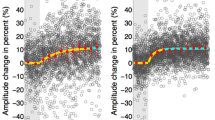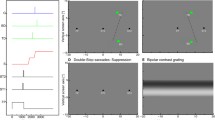Abstract
We investigated cognitive functions of attention and decision-making in 18 healthy subjects and 15 schizophrenia patients using an experimental design with consecutive presentation of two short visual stimuli (double-step). In patients with schizophrenia, an increase in the number of errors and change in the pattern of saccadic responses have been found: an increase of the number of two-saccade responses to each stimulus and a decrease in the number of single-saccade responses to the second stimulus. In schizophrenia patients, the latent period of the first of a pair of saccades has been shorter; and the latent period of single saccade has been increased in comparison with healthy subjects. Opposite lateral differences in latent periods of saccades in healthy subjects and schizophrenia patients have been found. Our results show the deficit of cognitive oculomotor control and a decrease in prognostic processes of saccade programming in schizophrenia patients.
Similar content being viewed by others
References
Broerse, A., Crawford, T.J., and Boer, J.A., Parsing cognition in schizophrenia using saccadic eye movements: A selective overview, Neuropsychologia, 2001, vol. 39, p. 742.
Camchong, J., Dyckman, K.A., Austin, B.P., et al., Common neural circuitry supporting volitional saccades and its disruption in schizophrenia patients and relatives, Biol. Psychiatry, 2008, vol. 64, no. 12, p. 1042.
Benson, Ph.J., Beedy, S.A., Shphard, E., et al., Simple viewing tests can detect eye movement abnormalities that distinguish schizophrenia cases from controls with exceptional accuracy, Biol. Psychiatry, 2012, vol. 72, p. 716.
Coull, J.T., Neural correlates of attention and arousal insights from electrophysiology, functional neuroimaging and psychopharmacology, Progr. Neurobiol., 1998, vol. 55, p. 343.
De Haan, B., Morgan, P.S., and Rorden, Ch., Covert orienting of attention and overt eye movements activate identical brain regions, Brain Res., 2008, vol. 1204, p. 102.
Eimer, M., Van Velzen, J., Cherry, E., and Press, C., Erp Correlates of shared control mechanisms involved in saccade preparation and in covert attention, Brain Res., 2007, vol. 1135, p. 134.
Kable, J. and Glimcher, P., The neurobiology of decision: Consensus and controvercy, Neuron, 2009, vol. 63, p. 733.
Becker, W., Saccadic eye movements as a control system, in The Neurobiology of Saccadic Eye Movements, Wurtz, R.H. and Goldberg, M.E., Eds., Amsterdam: Elsevier Sci. Publ. BV (Biomedical Division), 1989, p. 13.
Fischer, B. and Breitmeyer, E., Mechanisms of visual attention revealed by saccadic eye movements, Neuropsychology, 1987, vol. 25, p. 73.
Miller, E.K. and Cohen, J.D., An integrative theory of prefrontal cortex function, Annu. Rev. Neurosc., 2001, vol. 24, p. 167.
Kennerly, S.W. and Walton, M.E., Decision making and reward in frontal cortex: Complementary evidence from neurophysiological and neuropsychological studies, Behaiv. Neurosci., 2011, vol. 125, no. 3, p. 297.
Brown, J.K., Waltz, J.A., Strauss, G.P., et al., Hypotetical decision making in schizophrenia: The role of expected value computation and “irratational” biases, Psychiatry Res., 2013, vol. 209, no. 2, p. 142.
Paulus, M.P., Frank, L., Brown, G.G., and Braff, D.L., Schizophrenia subjects show intact success-related neural activation but impaired uncertainty processing during decision-making, Neuropsychopharmacology, 2003, vol. 28, no. 4, p. 795.
Lisberger, S., Fuch, A., King, W., and Evinger, L., Effect of mean reaction time on saccadic responses to two step stimuli with horizontal and vertical components, Visual Res., 1975, vol. 15, p. 1021.
Becker, W. and Jurgens, R., An analysis of the saccadic system by means of double step stimuli, Vision Res., 1979, vol. 19, no. 9, p. 967.
Klein, C., Rockstroh, B., Cohen, R., and Berg, P., Contongent negative variation (CNV) and determinants of the post-imperative negative variation (PINV) in schizophrenic patients and healthy controls, Schizophrenia Res., 1996, vol. 21, p. 97.
Goldman-Rakic, P.S., Topography of cognition: Parallel distributed networks in primate association cortex, Ann. Rev. Neurosci., 1988, vol. 11, p. 137.
Everling, S. and Fischer, B., The antisaccade: A review of basic research and clinical studies, Neuropsychology, 1998, vol. 36, no. 9, p. 885.
Lijffijt, M., Lane, S.D., Maiera, S.L., et al., LP50, N100, and P200 sensory gating: Relationships with behavioral inhibition, attention, and working memory, Psychophysiology, 2009, vol. 46, no. 5, p. 1059.
Strelets, V., Faber, P.L., Golikova, J., et al., Chronic schizophrenics have shortened EEG microstate durations, Clin. Neurophysiol., 2003, vol. 114, no. 11, p. 2043.
Nestor, P.G., Faux, S.F., McCarley, R.W., et al., Attention cues in chronic schizophrenia. abnormal disengagement of attention, J. Abnormal Psychol., 1992, vol. 101, p. 682.
Spencer, K.M., Nestor, P.G., Valdman, O., et al., Enhanced facilitation of spatial attention in schizophrenia, Neuropsychology, 2011, vol. 25, no. 1, p. 76.
Sommer, M.A. and Wurts, R.H., What the brain stem tells the frontal cortex: II. Role of the SC-MD-FEF pathway in corollary discharge, J. Neurophysiol., 2004, vol. 91, p. 1403.
Bender, S., Schroder, J., Freitag, C., et al., Movementrelated potentials point towards an impaired tuning of reafferent sensory feedback by preceding motor activation in schizophrenia, Psychiatry Res., 2012, vol. 202, no. 1, p. 65.
Maruff, P. and Hay, D., Asymmetries of the covert orienting of visual spatial attention in schizophrenia, Neurophysiology, 1995, vol. 33, no. 10, p. 1205.
Liotty, M., Dazzi, S., Fox, P.T., and Laberg, D., Deficits of automatic orienting of attention in schizophrenic patients, J. Psychiatr. Res., 1993, vol. 27, no. 1, p. 119.
Selemon, L.D. and Goldman-Rakic, P.S., The reduced neuropil hypothesis: A circuit based model of schizophrenia, Biol. Psychiatry, 1999, vol. 45, no. 1, p. 17.
Slavutskaya, M.V. and Shulgovskiy, V.V., Presaccadic brain potentials in conditions of covert attention orienting, Span. J. Physiol., 2007, vol. 10, no. 2, p. 277.
Bragina, N.N. and Dobrokhotova, T.A., Funktsional’nye asimmetrii cheloveka (Functional Asymmetries in Humans), Moscow: Meditsina, 1988.
Posner, M., Orienting of attention, J. Exp. Psychol., 1980, vol. 32, p. 3.
Moran, M.J. and Thaker, G.K., Covert visual attention in schizophrenia spectrum personality disordered subjects: Visuaspatial cuing and alerting effects, J. Psychiatric Res., 1996, vol. 30, no. 4, p. 261.
Pratt, G., Visual fixation offsets effects both the initiated and the kinematics feature of saccades, Exp. Brain Res., 1998, vol. 118, p. 135.
Author information
Authors and Affiliations
Corresponding author
Additional information
Original Russian Text © V.V. Shulgovskiy, M.V. Slavutskaya, I.S. Lebedeva, S.A. Karelin, V.V. Moiseeva, A.P. Kulaichev, V.G. Kaleda, 2015, published in Fiziologiya Cheloveka, 2015, Vol. 41, No. 4, pp. 37–43.
Rights and permissions
About this article
Cite this article
Shulgovskiy, V.V., Slavutskaya, M.V., Lebedeva, I.S. et al. Saccadic responses to consecutive visual stimuli in healthy people and patients with schizophrenia. Hum Physiol 41, 372–377 (2015). https://doi.org/10.1134/S0362119715040143
Received:
Published:
Issue Date:
DOI: https://doi.org/10.1134/S0362119715040143




